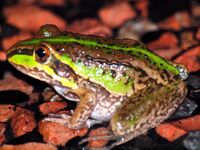Striped Burrowing Frog

Taxonomy
| Kingdom | Phylum | Class | Order | Family | Genus | Species | |
|---|---|---|---|---|---|---|---|
| Classification | Animalia | Chordata | Amphibia | Anura | Pelodryadidae | Ranoidea | Cyclorana alboguttata |
[2]
Description
The Striped Burrowing Frog or Cyclorana alboguttata is a species of Burrowing Frog known for its ability to bury itself in the mud for years without access to food or water. This ability is due to the heightened function of its Mitochondria, giving researchers hope for vital information regarding energy-dependent diseases such as Obesity and Mitochondrial Disease[1]
The Striped Burrowing Frog ranges in color with its dorsal ranging from olive, green or brown accompanied by darker markings. There are 1 to 3 pale yellow to yellow-green stripes down the middle of its back and along its sides. There is a black stripe from the base of its snout to its rear running across both eyes. The thighs range from light to dark brown to black with white spots and some brown specks along its chest and throat, both of which are white. Adult females grow to 85 mm in length and adult males grow to 70mm long. [3]
Habitat
The species is found along the East coast of Australia spanning from Sydney into the Northern Territory. [2] They can be found in woodlands and grassy regions around temporary pools or other sources of water. While they prefer ample rainfall and access to water, they are often found in dry or arid regions due to their ability to bury themselves in mud and enter a state of torpor while buried in the soil, further discussed under the 'Behavior' section. [3]
Anatomy
A Burrowing Frog resembles a non-burrowing frog in regards to placement of its key attributes such as head, abdomen, legs and Tympanum - an external oval protecting the frog's ear drums from water. Sound transfers through this into the inner ear canal of a frog. However, burrowing frogs have a more intensive muscle and skeletal structure in their legs to be able to dig the hole necessary to bury themselves. And unlike most frogs, their toes lack webbing to allow for better traction while digging.[8]
Diet & Behavior
Diet
Burrowing frogs are carnivores that eat a variety of invertebrates including spiders, ants and centipedes. They are generalists who eat species depending on their availability. They capture prey using their long tongue.[7]
Burrowing
Burrowing Frogs are known for their ability to bury themselves in moist soil during conditions of ample rainfall and remain there for extended periods of time without harm while the soil around them dries, only to emerge again when the conditions are wet enough. They use their back legs to dig a whole in the soil where they will remain from months to years at a time. They can store up to 50% of their body weight in water in their bladders. This will supply them with moisture while they are underground. Before they begin their state of torpor they release a shield of dead skin cells to act as a barrier to limit water loss.[4] During the state of torpor, their body does not require food because it decreases its metabolism, allowing the frog to maximize its energy supply without completely depleting its resources. [5]
Reproduction
The species breeds during spring and summer peaking in the months of January and February. Males call to females up to 3 months before breeding season and don't stop until 1 month after peak mating season. Females lay eggs along the edges of bodies of water and the male attaches themself to the back of the female and fertilizes the eggs externally after the female lays them. [6]
Life Cycle

Eggs
Eggs are laid in a foamy substance in shallow, still water such as ponds or temporary pools in groups of 500-800 called a frogspawn. They are laid just underneath the surface of the water, often under vegetation for added protection. These eggs remain dormant until rainfall washes them into a larger supply of water where Tadpole development begins.
Tadpole
Tadpoles take between 12 weeks and a year to develop depending on weather conditions. They are blue-gray in color with streaks of black. Tadpoles that have not matured by the time winter approaches, will go dormant for the cold season and resume development once it warms.
Adult Frog
Once Tadpoles fully mature they are considered adults and can live for 10 to 15 years. [7]
References
[1] L. S. S. 2009, June 29. Frog Dozes in Mud for Years. https://www.livescience.com/7772-frog-dozes-mud-years.html.
[3] Wildlife of Greater Brisbane. Brisbane: Queensland Museum. 2007. pp. 221. ISBN 978-0-9775943-1-3.
[4] Burrowing Frogs. (n.d.).https://backyardbuddies.org.au/backyard-buddies/burrowing-frogs/.
[5] Frost, D. R. 1999. Amphibian Species of the World: an Online Reference. American Museum of Natural History.
[6] Cyclorana alboguttata. (n.d.). . https://www.frogid.net.au/frogs/cyclorana-alboguttata.
[7] Burrowing Frog. (n.d.).https://a-z-animals.com/animals/burrowing-frog/#:~:text=The%20burrowing%20frog%20primarily%20consumes,catch%20and%20eat%20its%20prey.
[8] Tympanum (anatomy). 2022, March 14.https://www.wikiwand.com/en/Tympanum_(anatomy).
